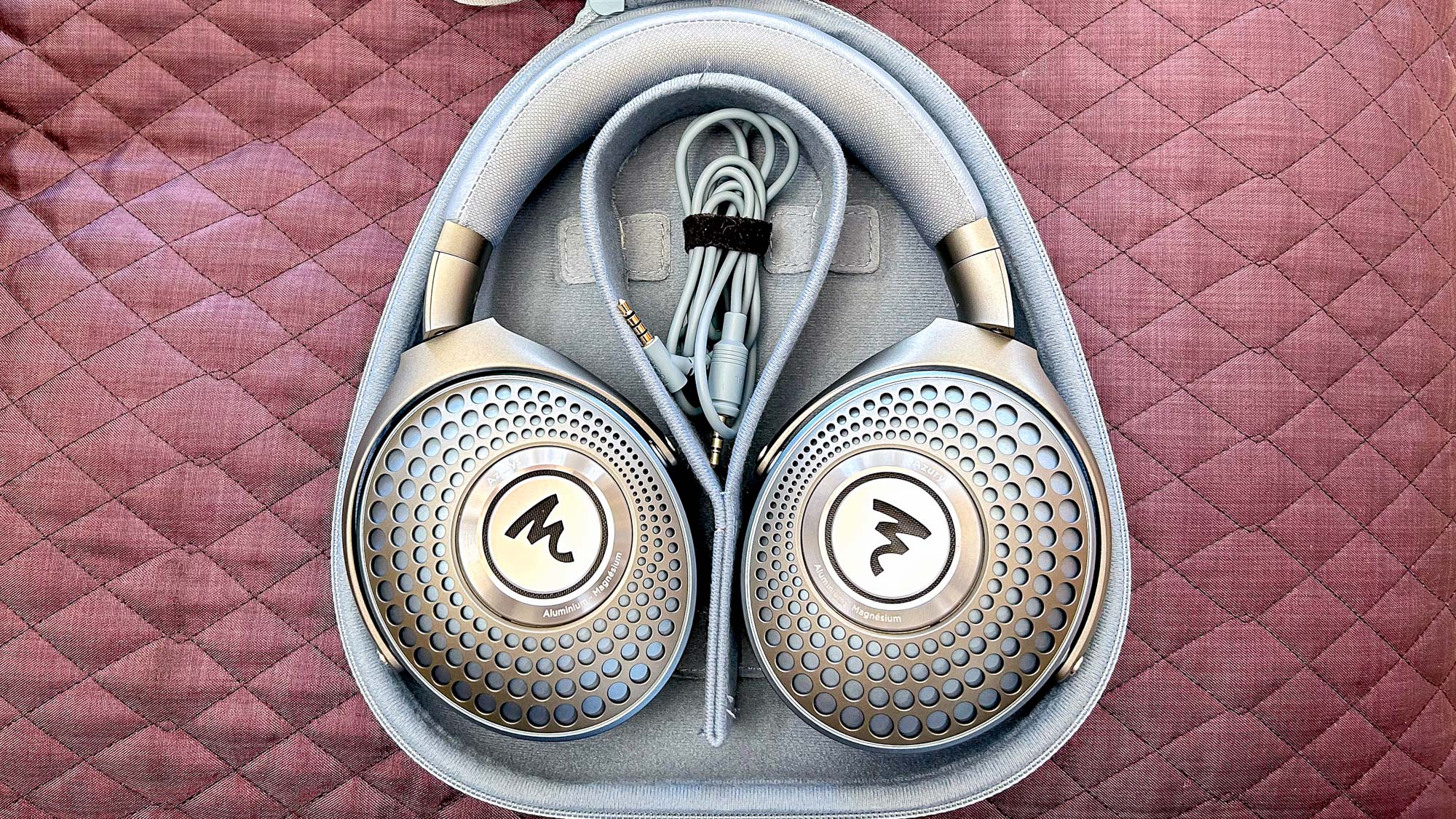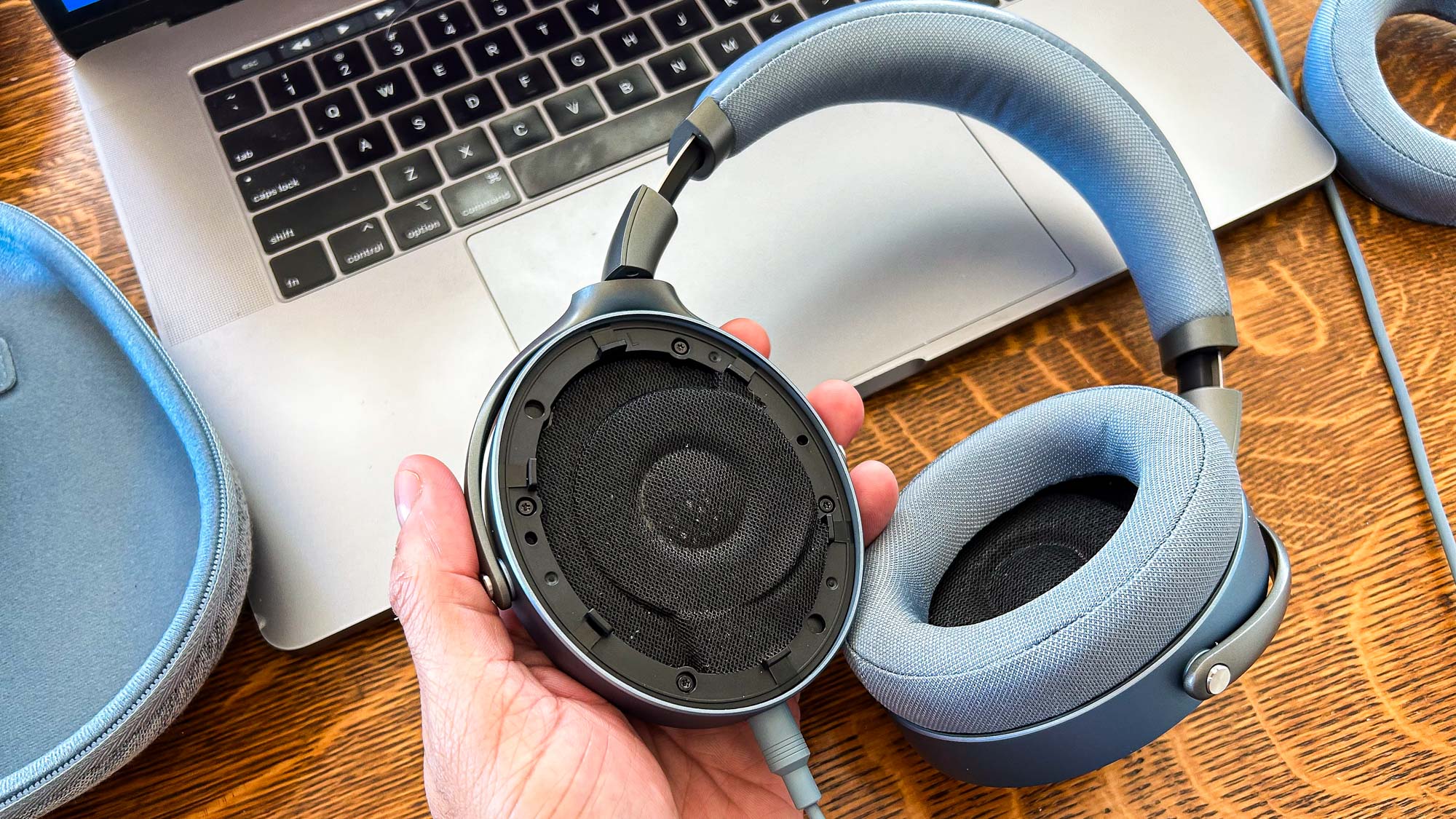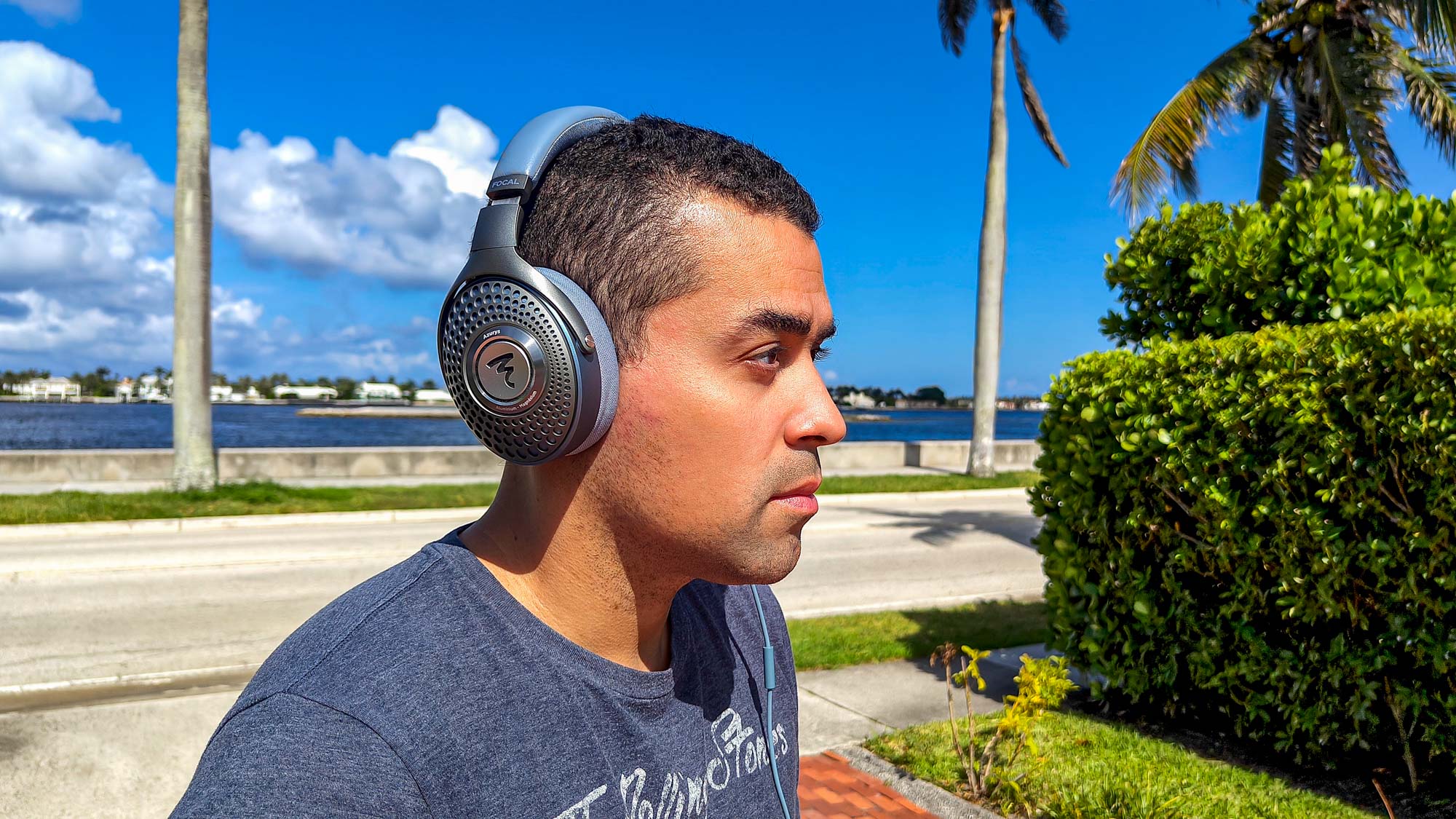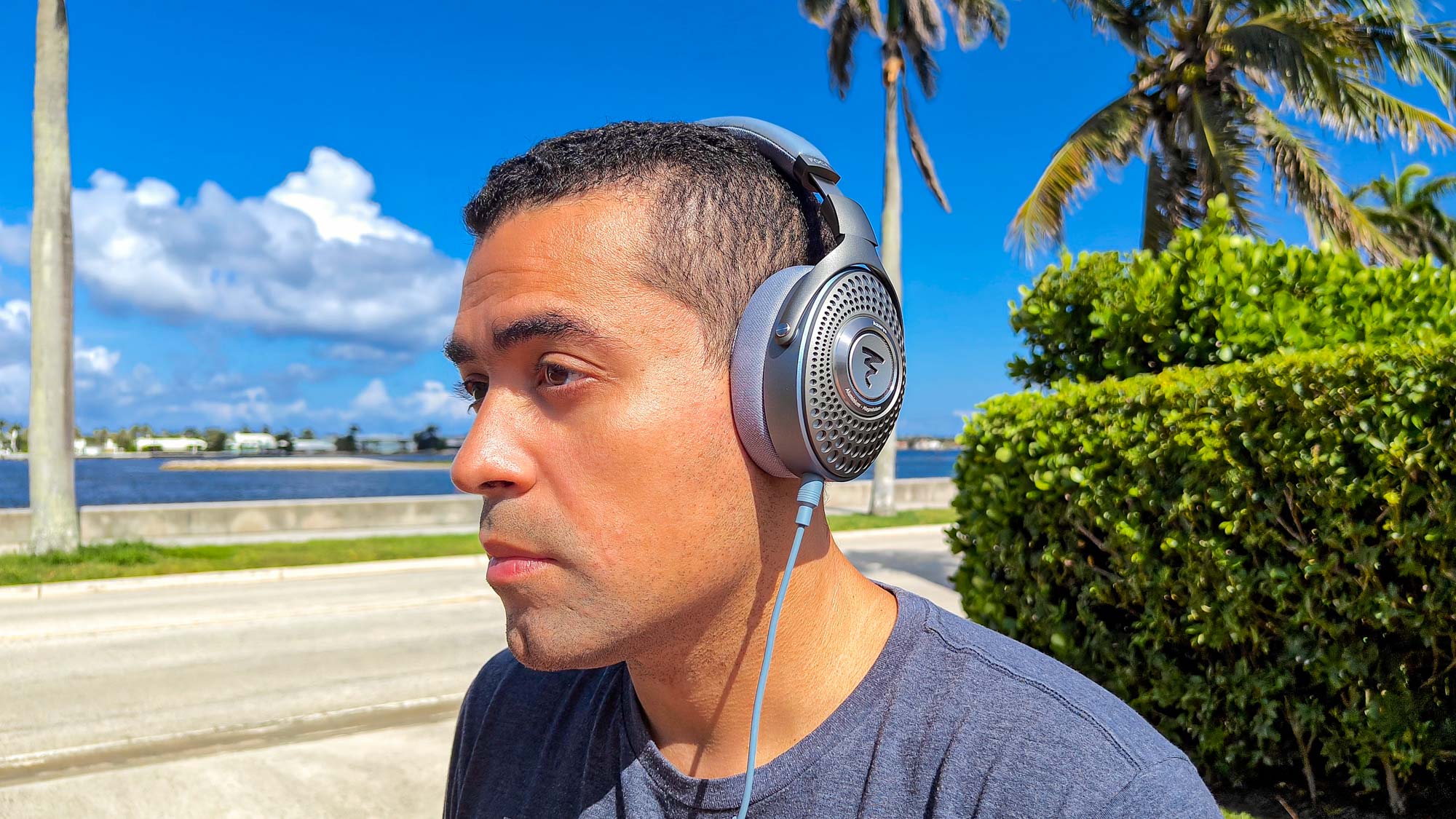Tom's Guide Verdict
Listed at the same steep price as the AirPods Max, the $549 Focal Azurys don't support wireless, but they sound superior and are the company’s most attainable headphones to date.
Pros
- +
Luxe craftsmanship and elite sound
- +
Stable performance across all devices and music platforms
- +
High comfort levels even after several hours of wear
Cons
- -
No wireless connectivity
- -
Middling call quality
- -
Bulky design
Why you can trust Tom's Guide
Price: $549 / £499 / AU$975
Colors: Azurite blue
Connectivity: 1x 4ft (1.25m) cable terminated with 3.5mm mini-jack at both ends
Drivers: 40mm M-shaped aluminium/magnesium dome
Size: Not specified
Weight: 10.72 ounces
With some of the best audiophile headphones on the market, Focal is a specialist audio brand with a Hi-Fi heritage. Its designs appeal to anyone looking for a step up from the main consumer tech brands popular among the best wireless headphones. Focal's target audience are audiophiles, engineers, and studio professionals — or any music lover that has a passion for the company's eye-catching, luxury designs with Hi-Fi sound and are willing to dig a little deeper into their pockets to achieve it.
That's not to say that the company hasn't strayed into more mainstream markets. It has done a commendable job of making their upscaled headphones more accessible with the $799 Bathys wireless headphones. The two recently introduced low-cost wired headphone entries continue to broaden the company's reach with the $549 Azurys and $699 Hadenys wired headphones.
In this review, I'm looking at the company's most affordable model. Can the Focal Azurys entry-level headphones with true audiophile architecture steal the sonic thunder of category leaders ranked among the best headphones? Read my full Focal Azurys review to find out.

Focal Azurys review: Price & availability
- Pre-order at select retailers priced at $549 / £499 / AU$975
- Available in azurite blue only
The Focal Azurys sell for $549 / £499 / AU$975 and are available to pre-order in Azurite Blue at select retailers like Headphones.com. They share the same MSRP as luxury as the AirPods Max, one the best noise-canceling headphones for iOS users, and are more affordable than the Focal Celestee ($999).
Focal Azurys review: Design

- Elegant craftsmanship
- Pleasant comfort for the size
- Not the lightest headphones out there
Focal’s penchant for sleek and sturdy construction is on full display. The Azurys have the same design and materials as the pricier Hadenys. They boast the brand’s signature honeycomb grilles, arched yokes, breathable woven fabric, genuine leather, and shiny magnesium, which is handsomely displayed. Each earpad can be removed and replaced when worn down. Unique touches like the insignia cutout and laser-etched text embellish their deluxe look. The gorgeous light blue colorway deserves a round of applause as well.
Music is blissful and engaging, and there’s terrific depth.
What’s most important about the design are the internals. Focal managed to squeeze their proprietary 40mm M-shaped aluminum/magnesium dome driver into these cans. According to the company, aluminum helps “increase dome rigidity and greatly reduces distortion” and magnesium “provides excellent damping.” The driver is engineered to deliver accurate sound with crisp vocals, deep bass, and smooth bass (more on that later).

The carrying case is substantial. On the outside is woven fabric, along with basic details like a built-in lanyard and embossed logo. The inside has a mesh pocket and plenty of space to store the headphones.
These are a bit chunkier and noticeably heavier (10.72 ounces) than Sony's WH-1000XM5 or Sennheiser's Momentum 4 Wireless wireless headphones. Lugging around the case adds weight to the equation. The plush padding on the earcups and headband makes the Azurys a comfortable wear. I’ve been using the headphones daily for 4-hour stretches and haven’t experienced any fatigue.
Focal Azurys review: Controls

- One-button control
- No on-board volume adjustment
- Digital assistant needs polishing
The headphones don’t have a multi-button setup or touch controls. Instead, you’re given a one-button module programmed for call management (answer/end call) and playback (play/pause/skip/back). It’s worth noting that the user manual doesn’t mention call functionality. The button produces solid tactility to ensure listeners of functions executing when performing the single- or multi-press gesture, at least when it comes to playback. There is no volume rocker, meaning you’ll have to adjust it manually on your media device.
You have access to the big three digital assistants: Alexa, Google Assistant, and Siri. The built-in mic does a decent job with speech capture and registers most voice commands. Lag is an issue when enabling Siri, and the function doesn’t always activate on macOS and Android when holding down the MF button.
Focal Azurys review: Sound quality

- Wide, spacious sound with remarkable frequency range
- Bass isn't as strong as other Focal headphones
- Sound wonderful with all devices and music platforms
It isn’t hyperbole to rank the Azurys up there with some of the best audiophile headphones under $1,000. That includes fancy releases like the Bowers & Wilkins Px8 and the sibling Bathys, as well as the wired Sennheiser HD 660S2. Focal’s drivers live up to their hype, dishing out vibrant hi-res sound with well-balanced frequencies.
I was also obsessed with the headphones’ sound accuracy.
The harmonics from the double bass on Lucky Daye’s “Little More Time” were fantastic. There was some nice bass elevation and reverberation. Instrumental separation was also amazing; the snappy drums and striking cymbal taps are equally prominent and transparent.
Mary J. Blige’s “Be Happy” showcased the Azurys’ natural delivery. Background details like the breeze effects and harp chords were more emphasized, which I don’t recall hearing much of on dynamic-sounding headphones like the WH-1000XM5.
Switching over to bass-heavy selections, Lenny Kravitz’s “Paralyzed” pumped out monstrous lows that were superbly reproduced. Killer guitar riffs and slapping snares dominated the soundscape. Even the purposely distorted electric guitar chords and vocals at the start of the recording sounded clean.

I was also obsessed with the headphones’ sound accuracy. Listening to the original recording of Eazy-E’s “Boyz-N-The-Hood”, it was shockingly satisfying to hear certain nuances like the crackling effects and hollow vocals, while enjoying the hard-hitting bassline that packs a punch, granted Focal’s higher-end headphones land a knockout blow.
Since these are wired headphones, there’s zero latency when plugged into a compatible audio source. Sound quality on the best music streaming platforms is on point, especially on Tidal where Master Quality Authenticated (MQA) tracks and the platform’s hidden features (e.g., Exclusive Mode, Loudness Normalization) boost clarity. Performance is also consistent across iOS/macOS and Android devices.
Focal recommends “running-in” the headphones for “at least 24 hours at a relatively high volume level, on tracks rich in low frequencies,” to achieve full audio performance. Whether there’s truth to the suggestion remains unknown right now, but the Azurys already sound great out of the box.
Focal Azurys review: Call quality

- Subpar voice calling
- Weak noise reduction
The Azurys is an acceptable calling headset that works if you’re in a pinch and need to contact someone. My wife could hear me clearly when grocery shopping, but she also heard all the background noise around me. Talking outside in gusty conditions drastically decreased call quality; the mic couldn’t handle the wind. Indoor calls fared better with several people bringing attention to the clarity and clearness on my end.
Focal Azurys review: Verdict
The Azurys are a fantastic-sounding pair of wired headphones. Music is blissful and engaging, thanks to Focal’s well-engineered audio design. There’s some terrific depth and frequency range to aurally consume. Bass doesn’t hit as hard as it does on other Focal headphones, or the WH-1000XM5, but it’s still impactful.
Going the wired route strips you of certain perks like a companion app with personalized features (e.g., EQ, spatial audio) and wireless connectivity. These headphones are also heavy and lack in call quality — two cons that affect their portability.
You’re probably thinking why spend the $549 on the Azurys when you can just pick up the AirPods Max and bask in their flawless interconnectivity with sound-enhancing features and smart controls. It’s not a terrible question to ask. Then again, you’re not looking at Focal headphones for their extended functionality, unless you pursue the Bathys.
In this case, you’re checking out the Azurys for their sound performance, and for a beginner model, this is an impressive debut that rewards listeners with many of the brand’s revered sonic characteristics at a significantly lower price point.
More from Tom's Guide
A lifestyle journalist with an affinity for consumer products, Alex has over a decade of experience and has worked with popular publications such as Complex, Thrillist, Men’s Health, Gear Patrol, AskMen, and Hoop Magazine. He currently focuses on audio, reviewing the most coveted headphones in the market for both Tom’s Guide and Laptop Magazine.


